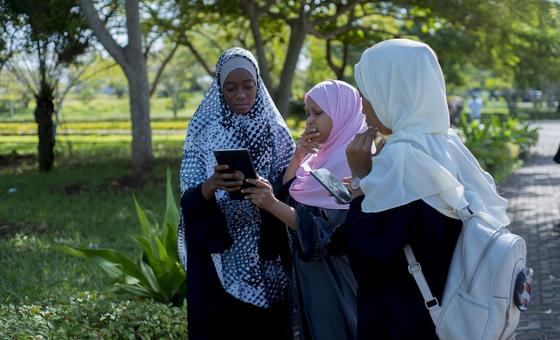Notwithstanding progress in increasing enrolment rates for primary education, 16.2 per cent of children of primary school age were out of school in least developed countries (LDCs) in 2019 and almost half of children out of school worldwide are in those same countries, with girls, children with disabilities and other children in vulnerable situations disproportionately represented.
Enrolment and completion rates for tertiary education remain low, which has far-reaching implications for the structural transformation agenda of the least developed countries. Most of them depend on aid for their education budgets. At the secondary and tertiary levels, gender disparities and disparities for the poorest and most vulnerable exist.
“Clearly, the education systems in the LDCs require significant development to equip their young people with the skills they need for the future,” said Ms. Fatima, who is also the UN High Representative for the Least Developed Countries, Landlocked Developing Countries and Small Island Developing States (UN-OHRLLS) at an LDC5 high-level side event on the proposed online university for LDCs.

Pandemic widens education gaps
The COVID-19 pandemic has exposed a major fault line in the education system, particularly in the LDCs. UNESCO‘s Global Survey of Higher Education, published in July 2021, found that the pandemic had affected 220 million tertiary students worldwide. In LDCs, almost all universities were forced to close completely.
While academic institutions in developed countries were able to move quickly to online education, LDCs were unable to make the switch due to a lack of the necessary logistics, technological tools, and skills.
In a world where technological progress is occurring at lightning speed, countries risk being left behind if they do not invest in the digital skills of tomorrow’s creators.
The best way to meet the growing demand for higher education at scale in an efficient, cost-effective, and resilient way is to rapidly build online education infrastructure in LDCs. A new UNESCO global survey on the impact of COVID-19 on higher education reveals that strong national efforts, supported by the international community, are urgently needed to develop online universities in LDCs.
“That is why the Doha Programme of Action (DPoA) has a concrete target in this area, to undertake feasibility studies for establishing an online university,” said Ms. Fatima, she said, referring to the Conference’s agreed outcome, which aims at removing structural obstacles to comprehensive growth and sustainable development.
A new online university
She explained that the main objectives of the proposed online university were to:
- Provide policy support to promote distance education and open learning for graduate and postgraduate studies in science, technology, engineering, and mathematics.
- Ensure special access for the poorest and those in vulnerable situations.
- Create a virtual network of educational institutions within and beyond the least developed countries.
- Support course design and curriculum development.
- Bring scale and sustainability to the education system, consider all existing initiatives developed by relevant partners.
- And facilitate global recognition and accreditation to international standards.
As requested by the DPoA, the UN Secretary-General will submit a report outlining the mapping of existing initiatives, possible new modalities, resource requirements, accreditation, and sustainable sources of funding.
This will be submitted to the UN General Assembly for consideration at its 78th session in September.
“I therefore echo the Secretary-General’s call, as he urged development partners to reverse budget cuts, and to dedicate at least 15 per cent of official development assistance to education,” said Ms. Fatima.
She added: “International financial institutions should also be looking to make more resources and fiscal space available for LDCs to invest in support of quality education for all.”
“This initiative, along with the other education goals and ambitions of the Doha Programme can equip millions of young girls and boys to become agents of transformative change, though newfound innovation and entrepreneurial skills.”
During the side event, Member States, international organizations, civil society groups, the private sector and youth representatives discussed the political and financial support needed to establish an online event.
A summary of the discussions was circulated and will contribute to the Secretary-General’s study on possible options for an online university.

Education programmes to stimulate innovation
This week at LDC5, the Qatar National Conference Centre has also hosted a number of civil society and academic representatives, including Professor Shijian Luo from China, who spoke to UN News.
Luo is the Dean of the International School of Design, Ningbo Innovation Centre, Zhejiang University (ZJU-ISD). The International Design Education (IDE) programme initiated at his school is dedicated to providing industrial design education to students from LDCs in order to enhance the capacity and competitiveness of LDCs in industrial design.
“Each year, the programme offers up to 50 full scholarships to eligible students from LDCs. These scholarships, supported by the university and the government, enable the students to study industrial design and cultivate their problem-solving skills,” Mr. Luo said at an exhibition showcasing the students’ industrial design productions.
He said that 68 students from 19 LDCs have been accepted into the 2.5-year programme in 2021 and 2022. “The programme also serves as an incubator to support students’ innovation and entrepreneurship by providing business support, research and services that help turn ideas in the classroom into start-ups in the market,” he added.
The professor explained that the long-term goal of the programme is to build the capacity of the world’s 46 LDCs in science, technology, and innovation (STI), which will contribute to the achievement of the SDGs.
“Our students are interested in bringing some of China’s experience in designing poverty alleviation or rural revitalization to their countries,””Mr. Luo said.
The IDE programme is jointly organised by the United Nations Technology Bank for Least Developed Countries (UNTB), the World Eco-Design Conference (WEDC) and ZJU-ISD since 2021.
The UNTB was established in 2016 as a subsidiary body of the UN General Assembly to help LDCs strengthen their STI capacities. It currently serves 46 LDCs and former LDCs for up to five years after their graduation from the category.

